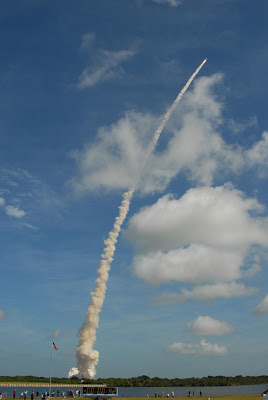Astronomy


NASA's 327-foot (100 m) tall ARes I-X rocket launched at 11:30 a.m. from Kennedy Space Center in Florida on Wednesday. The powered flight lasted for two minutes, at the end of which, the rocket's first stage, a four-segment solid rocket booster, separated. This and the solid rocket motor were later recovered for inspection and tests (image at right). The upper stage, simulating the Orion module and launch abort system, was not recovered. The rocket was able to reach Mach 4.76 and an altitude of 150,000 feet (45.7 km) just after the conclusion of the powered flight.
 The flight was the first test flight for the Ares I program, NASA's next launch system for human spaceflight (concept image at left). The Ares I vehicle will launch the Orion spacecraft and the astronauts on board for future human spaceflight missions, which may even include missions to the Moon and Mars.
The flight was the first test flight for the Ares I program, NASA's next launch system for human spaceflight (concept image at left). The Ares I vehicle will launch the Orion spacecraft and the astronauts on board for future human spaceflight missions, which may even include missions to the Moon and Mars.
The trial performed by the Ares I-X rocket allowed NASA to test necessary equipment, bot on the vehicle and on the ground. Engineers were able to analyze data received from the 700 sensors on the rocket alone. The findings gained from the flight will help further development on the Ares I program, which is expected to begin carrying human payload by around 2015.
A video of the Ares I-X launch is available after the break.
Images and Video: NASA
Astronomy and Space Celebrates International Year of Astronomy 2009.
- Astronauts Can Now Escape From An Exploding Rocket
NASA has spent $220 million on testing a new escape system rocket in New Mexico on this Thursday dummy crew module more than a mile up in just 20 seconds to demonstrate how a future manned spacecraft could be pulled to safety in the event of a catastrophic...
- North Korean Rocket Flew Further Than Earlier Thought
New details emerging from the analysis of data from North Korea's April 5 Taepo-Dong-2 test indicate the vehicle flew successfully several hundred miles further than previously believed and used more advanced steering than has been demonstrated by...
- Preparing For The Moon
Image: NASA The picture shows the second stage of the Saturn V rocket being prepared for testing on the A-2 test stand at the Mississippi Test Facility (now called the Stennis Space Center) in 1967. The Saturn V rocket is still the largest and most powerful...
- Sts-128 Launch
Update 4: NASA has decided to attempt launching at 11:59 p.m. on Friday, August 28. This is to allow more time for the engineers to analyze the problem that had occurred. Update 3: During the 48 hour scrub, NASA will try to analyze the problem....
- India Successfully Launched Gslv Mark-iii
India took a giant leap forward toward its ambitious goal of sending humans into space by launching an unmanned crew capsule with a powerful rocket. ISRO [Indian Space Research Organization] launched the 630-ton rocket from its facility at Sriharikota...
Astronomy
NASA's Ares I-X Rocket Launches for Flight Test


 The flight was the first test flight for the Ares I program, NASA's next launch system for human spaceflight (concept image at left). The Ares I vehicle will launch the Orion spacecraft and the astronauts on board for future human spaceflight missions, which may even include missions to the Moon and Mars.
The flight was the first test flight for the Ares I program, NASA's next launch system for human spaceflight (concept image at left). The Ares I vehicle will launch the Orion spacecraft and the astronauts on board for future human spaceflight missions, which may even include missions to the Moon and Mars.The trial performed by the Ares I-X rocket allowed NASA to test necessary equipment, bot on the vehicle and on the ground. Engineers were able to analyze data received from the 700 sensors on the rocket alone. The findings gained from the flight will help further development on the Ares I program, which is expected to begin carrying human payload by around 2015.
A video of the Ares I-X launch is available after the break.
Images and Video: NASA
Astronomy and Space Celebrates International Year of Astronomy 2009.
- Astronauts Can Now Escape From An Exploding Rocket
NASA has spent $220 million on testing a new escape system rocket in New Mexico on this Thursday dummy crew module more than a mile up in just 20 seconds to demonstrate how a future manned spacecraft could be pulled to safety in the event of a catastrophic...
- North Korean Rocket Flew Further Than Earlier Thought
New details emerging from the analysis of data from North Korea's April 5 Taepo-Dong-2 test indicate the vehicle flew successfully several hundred miles further than previously believed and used more advanced steering than has been demonstrated by...
- Preparing For The Moon
Image: NASA The picture shows the second stage of the Saturn V rocket being prepared for testing on the A-2 test stand at the Mississippi Test Facility (now called the Stennis Space Center) in 1967. The Saturn V rocket is still the largest and most powerful...
- Sts-128 Launch
Update 4: NASA has decided to attempt launching at 11:59 p.m. on Friday, August 28. This is to allow more time for the engineers to analyze the problem that had occurred. Update 3: During the 48 hour scrub, NASA will try to analyze the problem....
- India Successfully Launched Gslv Mark-iii
India took a giant leap forward toward its ambitious goal of sending humans into space by launching an unmanned crew capsule with a powerful rocket. ISRO [Indian Space Research Organization] launched the 630-ton rocket from its facility at Sriharikota...
